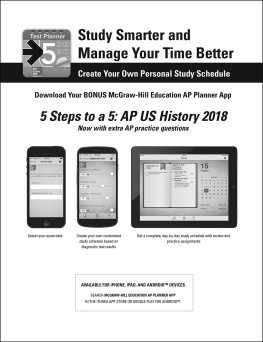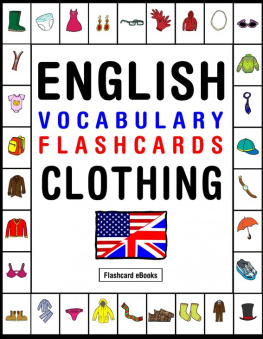5 STEPS TO A 5
AP World History FLASHCARDSPeggy J. Martin

Copyright 2012 by The McGraw-Hill Companies, Inc. All rights reserved. Printed in China. Except as permitted under the United States Copyright Act of 1976, no part of this publication may be reproduced or distributed in any form or by any means, or stored in a database or retrieval system, without the prior written permission of the publisher. ISBN: 978-0-07-178065-0 MHID: 0-07-178065-3 The material in this eBook also appears in the print version of this title: ISBN: 978-0-07-178064-3, MHID: 0-07-178064-5.
All trademarks are trademarks of their respective owners. Rather than put a trademark symbol after every occurrence of a trademarked name, we use names in an editorial fashion only, and to the benefit of the trademark owner, with no intention of infringement of the trademark. Where such designations appear in this book, they have been printed with initial caps. McGraw-Hill eBooks are available at special quantity discounts to use as premiums and sales promotions, or for use in corporate training programs. To contact a representative please e-mail us at bulksales@mcgraw-hill.com. Trademarks: McGraw-Hill, the McGraw-Hill Publishing logo, 5 Steps to a 5, and related trade dress are trademarks or registered trademarks of The McGraw-Hill Companies and/or its affiliates in the United States and other countries and may not be used without written permission.
All other trademarks are the property of their respective owners. The McGraw-Hill Companies is not associated with any product or vendor mentioned in this book. TERMS OF USE This is a copyrighted work and The McGraw-Hill Companies, Inc. (McGraw-Hill) and its licensors reserve all rights in and to the work. Use of this work is subject to these terms. Except as permitted under the Copyright Act of 1976 and the right to store and retrieve one copy of the work, you may not decompile, disassemble, reverse engineer, reproduce, modify, create derivative works based upon, transmit, distribute, disseminate, sell, publish or sublicense the work or any part of it without McGraw-Hills prior consent.
You may use the work for your own noncommercial and personal use; any other use of the work is strictly prohibited. Your right to use the work may be terminated if you fail to comply with these terms. THE WORK IS PROVIDED AS IS. McGRAW-HILL AND ITS LICENSORS MAKE NO GUARANTEES OR WARRANTIES AS TO THE ACCURACY, ADEQUACY OR COMPLETENESS OF OR RESULTS TO BE OBTAINED FROM USING THE WORK, INCLUDING ANY INFORMATION THAT CAN BE ACCESSED THROUGH THE WORK VIA HYPERLINK OR OTHERWISE, AND EXPRESSLY DISCLAIM ANY WARRANTY, EXPRESS OR IMPLIED, INCLUDING BUT NOT LIMITED TO IMPLIED WARRANTIES OF MERCHANTABILITY OR FITNESS FOR A PARTICULAR PURPOSE. McGraw-Hill and its licensors do not warrant or guarantee that the functions contained in the work will meet your requirements or that its operation will be uninterrupted or error free. Neither McGraw-Hill nor its licensors shall be liable to you or anyone else for any inaccuracy, error or omission, regardless of cause, in the work or for any damages resulting therefrom.
McGraw-Hill has no responsibility for the content of any information accessed through the work. Under no circumstances shall McGraw-Hill and/or its licensors be liable for any indirect, incidental, special, punitive, consequential or similar damages that result from the use of or inability to use the work, even if any of them has been advised of the possibility of such damages. This limitation of liability shall apply to any claim or cause whatsoever whether such claim or cause arises in contract, tort or otherwise.
Introduction
McGraw-Hills
5 Steps to a 5: AP World History Flashcards is designed to provide a portable way for students to build their knowledge of world history in preparation for the AP exam. These cards contain 600 terms and their definitions. The cards are numbered so that the terms coincide with the chapter chronology in
5 Steps to a 5: AP World History.
You can arrange the deck to suit your own study needs. You can remove terms you know from the deck or can mix up the cards for complete randomization. If you need to find the location of a term in the deck, refer to the cards in the front that provide an alphabetical list of terms and their corresponding card numbers. TERM
Civilization
Civilization Advanced cities Complex institutions Skilled workers Advanced technology A system of record keeping
Climate
Climate The pattern of temperature and precipitation over a period of time Largely determined by latitude
Cultural Diffusion
Cultural Diffusion The transmission of ideas and products from one culture to another Example: the spread of agriculture in Eurasia
Independent Invention
Independent Invention A societys development of technology through its own inventiveness Example: iron working in Kush
Monsoon
Monsoon A seasonal wind Guided sailors through the Indian Ocean
Steppe
Steppe A dry grassland Example: Steppes of Central Asia
AP World Periods
AP World Periods Foundations (8000 B.C.E.600 C.E.) Two (6001450) Three (14501750) Four (17501914) Five (1914Present)
AP Date Designations
AP Date Designations B.C.E. (Before the Common Era) C.E. and A.D., respectively
AP World Themes
AP World Themes Human-environmental interaction Cultural interaction Political development Economic systems Change in social structures
Arctic Ocean
Arctic Ocean Smallest ocean Packed in ice most of the year Difficult to navigate Location of the Northwest Passage sought by early explorers
Indian Ocean
Indian Ocean Third largest ocean Extensive trade Monsoon winds Commercial rivalries
Atlantic Ocean
Atlantic Ocean Second largest ocean Columbian Exchange Caribbean plantations Greco-Roman civilization
Pacific Ocean
Pacific Ocean Largest ocean Dotted with islands Polynesian voyagers Manila galleons WWII island-hopping
Foundations: Key Comparisons
Foundations: Key Comparisons Agriculture in the Eastern and Western Hemispheres Spread of Buddhism, Hinduism, and Christianity Decline and fall of Han China, Rome, and Gupta India
Period Two: Key Comparisons
Period Two: Key Comparisons Feudalism in Japan and Western Europe Mongol rule in Russia and China Chinese and Europeans in the Indian Ocean Muslim Spain and feudal Europe
Period Three: Key Comparisons
Period Three: Key Comparisons Reactions of Japan and China to Western influence Gender roles in Ming China and Western Europe Western European versus Asian and Ottoman technology
Period Four: Key Comparisons
Period Four: Key Comparisons The Industrial Revolution in Japan, Europe, and Russia Revolutions: American, French, Haitian, Mexican (1910), and Chinese Imperialism in India and Africa







 Copyright 2012 by The McGraw-Hill Companies, Inc. All rights reserved. Printed in China. Except as permitted under the United States Copyright Act of 1976, no part of this publication may be reproduced or distributed in any form or by any means, or stored in a database or retrieval system, without the prior written permission of the publisher. ISBN: 978-0-07-178065-0 MHID: 0-07-178065-3 The material in this eBook also appears in the print version of this title: ISBN: 978-0-07-178064-3, MHID: 0-07-178064-5.
Copyright 2012 by The McGraw-Hill Companies, Inc. All rights reserved. Printed in China. Except as permitted under the United States Copyright Act of 1976, no part of this publication may be reproduced or distributed in any form or by any means, or stored in a database or retrieval system, without the prior written permission of the publisher. ISBN: 978-0-07-178065-0 MHID: 0-07-178065-3 The material in this eBook also appears in the print version of this title: ISBN: 978-0-07-178064-3, MHID: 0-07-178064-5.